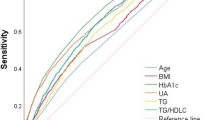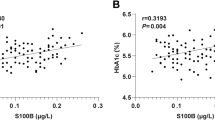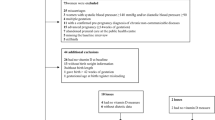Abstract
Objectives:
To evaluate the maternal serum 25(OH)D concentrations and its association with gestational diabetes and other pregnancy outcomes.z
Methods:
In our nested case–control study, 4718 pregnancy women were included, who were attending second- and third-trimester screening in Nanjing, China. Serum 25(OH)D concentrations were tested by enzyme-linked immunoassay, and the pregnancy and birth outcomes were obtained via electronic medical record collection and information extraction. The associations of 25(OH)D concentrations with gestational diabetes and other pregnancy outcomes were assessed by logistic regression analysis. And receiver-operator characteristic curve analysis was also conducted.
Results:
For the total population, the median (IQR) concentrations of 25(OH)D was 43.7 (35.5–57.9) nmol l−1, and 63.1% of women had concentrations <50.0 nmol l−1. The 25(OH)D concentrations was significantly lower in gestational diabetes patients than in controls. Moreover, after adjustment for confounders, women with low 25(OH)D concentrations had significantly increased risks of gestational diabetes and some adverse pregnancy outcomes (anemia, macrosomia, abnormal amniotic fluid, and miscarriage or stillbirth). We also observed a threshold for 25(OH)D of 50.0 nmol l−1 for gestational diabetes and a nice predictive accuracy of the 25(OH)D concentrations included panel, with an area under the curve of 0.625 for gestational diabetes.
Conclusions:
Low 25(OH)D concentrations (<50.0 nmol l−1) in pregnancy was significantly associated with gestational diabetes risk, and it may serve as biomarkers for the surveillance of high-risk pregnant women.
This is a preview of subscription content, access via your institution
Access options
Subscribe to this journal
Receive 12 print issues and online access
$259.00 per year
only $21.58 per issue
Buy this article
- Purchase on Springer Link
- Instant access to full article PDF
Prices may be subject to local taxes which are calculated during checkout
Similar content being viewed by others
References
Bell TD, Demay MB, Burnett-Bowie SA . The biology and pathology of vitamin D control in bone. J Cell Biochem 2010; 111: 7–13.
Ponsonby AL, Lucas RM, Lewis S, Halliday J . Vitamin D status during pregnancy and aspects of offspring health. Nutrients 2010; 2: 389–407.
Liu NQ, Hewison M . Vitamin D, the placenta and pregnancy. Arch Biochem Biophys 2012; 523: 37–47.
Brannon PM, Picciano MF . Vitamin D in pregnancy and lactation in humans. Annu Rev Nutr 2011; 31: 89–115.
Practice ACoO. ACOG Committee Opinion No. 495: Vitamin D: screening and supplementation during pregnancy. Obstet Gynecol 2011; 118: 197–198.
National Collaborating Centre for Women's and Children's Health (UK) Antenatal Care: Routine Care for the Healthy Pregnant Woman. RCOG Press: London, 2008.
Holick MF, Binkley NC, Bischoff-Ferrari HA, Gordon CM, Hanley DA, Heaney RP et al. Evaluation, treatment, and prevention of vitamin D deficiency: an Endocrine Society Clinical Practice Guideline. J Clin Endocrinol Metab 2011; 96: 1911–1930.
Institute of Medicine (US) Committee to Review Dietary Reference Intakes for Vitamin D and Calcium. In: Ross AC, Taylor CL, Yaktine AL, Del Valle HB (eds). Dietary Reference Intakes for Calcium and Vitamin D. National Academies Press: Washington, DC, USA, 2011.
Hollis BW . Circulating 25-hydroxyvitamin D levels indicative of vitamin D sufficiency: implications for establishing a new effective dietary intake recommendation for vitamin D. J Nutr 2005; 135: 317–322.
Nassar N, Halligan GH, Roberts CL, Morris JM, Ashton AW . Systematic review of first-trimester vitamin D normative levels and outcomes of pregnancy. Am J Obstet Gynecol 2011; 205 (208): e1–e7.
Burris HH, Rifas-Shiman SL, Camargo CA Jr, Litonjua AA, Huh SY, Rich-Edwards JW et al. Plasma 25-hydroxyvitamin D during pregnancy and small-for-gestational age in black and white infants. Ann Epidemiol 2012; 22: 581–586.
Gernand AD, Simhan HN, Klebanoff MA, Bodnar LM . Maternal serum 25-hydroxyvitamin D and measures of newborn and placental weight in a US multicenter cohort study. J Clin Endocrinol Metab 2013; 98: 398–404.
Schneuer FJ, Roberts CL, Guilbert C, Simpson JM, Algert CS, Khambalia AZ et al. Effects of maternal serum 25-hydroxyvitamin D concentrations in the first trimester on subsequent pregnancy outcomes in an Australian population. Am J Clin Nutr 2014; 99: 287–295.
Hossain N, Kanani FH, Ramzan S, Kausar R, Ayaz S, Khanani R et al. Obstetric and neonatal outcomes of maternal vitamin D supplementation: results of an open-label, randomized controlled trial of antenatal vitamin D supplementation in Pakistani women. J Clin Endocrinol Metab 2014; 99: 2448–2455.
De-Regil LM, Palacios C, Lombardo LK, Pena-Rosas JP . Vitamin D supplementation for women during pregnancy. Cochrane Database Syst Rev 2016; 1: CD008873.
Zhang MX, Pan GT, Guo JF, Li BY, Qin LQ, Zhang ZL . Vitamin D deficiency increases the risk of gestational diabetes mellitus: a meta-analysis of observational studies. Nutrients 2015; 7: 8366–8375.
Lu M, Xu Y, Lv L, Zhang M . Association between vitamin D status and the risk of gestational diabetes mellitus: a meta-analysis. Arch Gynecol Obstet 2016; 293: 959–966.
Hypponen E, Cavadino A, Williams D, Fraser A, Vereczkey A, Fraser WD et al. Vitamin D and pre-eclampsia: original data, systematic review and meta-analysis. Ann Nutr Metab 2013; 63: 331–340.
Tabesh M, Salehi-Abargouei A, Tabesh M, Esmaillzadeh A . Maternal vitamin D status and risk of pre-eclampsia: a systematic review and meta-analysis. J Clin Endocrinol Metab 2013; 98: 3165–3173.
Zhu P, Tong SL, Hu WB, Hao JH, Tao RX, Huang K et al. Cord blood 25-hydroxyvitamin D and fetal growth in the China-Anhui Birth Cohort Study. Sci Rep 2015; 5: 14930.
Aghajafari F, Nagulesapillai T, Ronksley PE, Tough SC, O'Beirne M, Rabi DM . Association between maternal serum 25-hydroxyvitamin D level and pregnancy and neonatal outcomes: systematic review and meta-analysis of observational studies. BMJ 2013; 346: f1169.
Moller UK, Streym S, Heickendorff L, Mosekilde L, Rejnmark L . Effects of 25OHD concentrations on chances of pregnancy and pregnancy outcomes: a cohort study in healthy Danish women. Eur J Clin Nutr 2012; 66: 862–868.
Fernandez-Alonso AM, Dionis-Sanchez EC, Chedraui P, Gonzalez-Salmeron MD, Perez-Lopez FR, The Spanish Vitamin D and Women's Health Research Group. First-trimester maternal serum 25-hydroxyvitamin D(3) status and pregnancy outcome. Int J Gynaecol Obstet 2012; 116: 6–9.
Yu CK, Ertl R, Skyfta E, Akolekar R, Nicolaides KH . Maternal serum vitamin D levels at 11-13 weeks of gestation in preeclampsia. J Hum Hypertens 2013; 27: 115–118.
Baker AM, Haeri S, Camargo CA Jr, Stuebe AM, Boggess KA . First-trimester maternal vitamin D status and risk for gestational diabetes (GDM) a nested case-control study. Diabetes Metab Res Rev 2012; 28: 164–168.
Hoffman L, Nolan C, Wilson JD, Oats JJ, Simmons D . Gestational diabetes mellitus—management guidelines. The Australasian Diabetes in Pregnancy Society. Med J Aust 1998; 169: 93–97.
American College of O, Gynecologists, Task Force on Hypertension in P. Hypertension in pregnancy. Report of the American College of Obstetricians and Gynecologists' Task Force on Hypertension in Pregnancy. Obstet Gynecol 2013; 122: 1122–1131.
Wen J, Song C, Jiang D, Jin T, Dai J, Zhu L et al. Hepatitis B virus genotype, mutations, human leukocyte antigen polymorphisms and their interactions in hepatocellular carcinoma: a multi-centre case-control study. Sci Rep 2015; 5: 16489.
Song SJ, Si S, Liu J, Chen X, Zhou L, Jia G et al. Vitamin D status in Chinese pregnant women and their newborns in Beijing and their relationships to birth size. Public Health Nutr 2013; 16: 687–692.
Bodnar LM, Simhan HN, Powers RW, Frank MP, Cooperstein E, Roberts JM . High prevalence of vitamin D insufficiency in black and white pregnant women residing in the northern United States and their neonates. J Nutr 2007; 137: 447–452.
Marwaha RK, Tandon N, Chopra S, Agarwal N, Garg MK, Sharma B et al. Vitamin D status in pregnant Indian women across trimesters and different seasons and its correlation with neonatal serum 25-hydroxyvitamin D levels. Br J Nutr 2011; 106: 1383–1389.
Rudnicki PM, Molsted-Pedersen L . Effect of 1,25-dihydroxycholecalciferol on glucose metabolism in gestational diabetes mellitus. Diabetologia 1997; 40: 40–44.
McLean E, Cogswell M, Egli I, Wojdyla D, de Benoist B . Worldwide prevalence of anaemia, WHO Vitamin and Mineral Nutrition Information System, 1993-2005. Public Health Nutr 2009; 12: 444–454.
Monlezun DJ, Camargo CA Jr, Mullen JT, Quraishi SA . Vitamin D status and the risk of anemia in community-dwelling adults: results from the National Health and Nutrition Examination Survey 2001-2006. Medicine (Baltimore) 2015; 94: e1799.
Atkinson MA, Melamed ML, Kumar J, Roy CN, Miller ER III, Furth SL et al. Vitamin D, race, and risk for anemia in children. J Pediatr 2014; 164: 153–158 e1.
Lee JA, Hwang JS, Hwang IT, Kim DH, Seo JH, Lim JS . Low vitamin D levels are associated with both iron deficiency and anemia in children and adolescents. Pediatr Hematol Oncol 2015; 32: 99–108.
Nobles CJ, Markenson G, Chasan-Taber L . Early pregnancy vitamin D status and risk for adverse maternal and infant outcomes in a bi-ethnic cohort: the Behaviors Affecting Baby and You (B.A.B.Y.) Study. Br J Nutr 2015; 114: 2116–2128.
Yilmaz S, Aktulay A, Demirtas C, Engin-Ustun Y . Low cord blood serum levels of vitamin D: cause or effect of fetal macrosomia? Clin Exp Obstet Gynecol 2015; 42: 501–504.
He CS, Gleeson M, Fraser WD . Measurement of circulating 25-hydroxy vitamin d using three commercial enzyme-linked immunosorbent assay kits with comparison to liquid chromatography: tandem mass spectrometry method. ISRN Nutr 2013; 2013: 723139.
Gallo S, Comeau K, Agellon S, Vanstone C, Sharma A, Jones G et al. Methodological issues in assessing plasma 25-hydroxyvitamin D concentration in newborn infants. Bone 2014; 61: 186–190.
Acknowledgements
This work was supported in part by the National Key Basic Research Program of China (2013CB530604), the Key project of the National Natural Science Foundation of China (81330067), the National Natural Science Foundation of China (81270928, 81301173, 81300683, 81500649 and 81600685), the Natural Science Foundation of Jiangsu Province (BK20140086 and BK20160141), the Medical Science and technology development Foundation (JQX13012), and the Science and Technology Development Fund of the Nanjing Medical University (2015NJMUZD062).
Author information
Authors and Affiliations
Corresponding authors
Ethics declarations
Competing interests
The authors declare no conflict of interest.
Additional information
Supplementary Information accompanies this paper on International Journal of Obesity website
Supplementary information
Rights and permissions
About this article
Cite this article
Wen, J., Hong, Q., Zhu, L. et al. Association of maternal serum 25-hydroxyvitamin D concentrations in second and third trimester with risk of gestational diabetes and other pregnancy outcomes. Int J Obes 41, 489–496 (2017). https://doi.org/10.1038/ijo.2016.227
Received:
Revised:
Accepted:
Published:
Issue Date:
DOI: https://doi.org/10.1038/ijo.2016.227
This article is cited by
-
Maternal vitamin D status and risk of gestational diabetes mellitus in twin pregnancies: a longitudinal twin pregnancies birth cohort study
Nutrition Journal (2024)
-
High Levels of 25-OH-Vitamin D and Copper in Pregnant Women with Abnormal Glucose Challenge Test
Biological Trace Element Research (2022)
-
Effect of maternal vitamin D status on risk of adverse birth outcomes: a systematic review and dose–response meta-analysis of observational studies
European Journal of Nutrition (2022)
-
Relationship between vitamin D status and the vaginal microbiome during pregnancy
Journal of Perinatology (2019)
-
Prediction of vaginal birth after cesarean delivery in Chinese parturients
Scientific Reports (2018)



